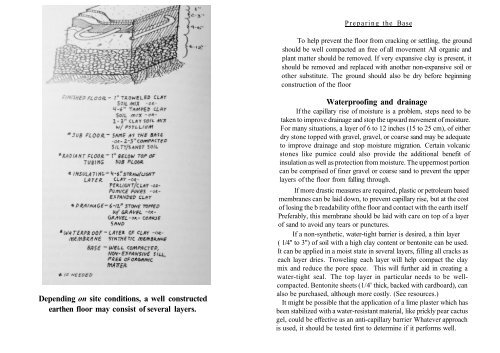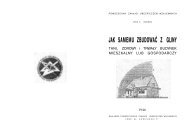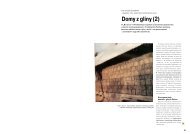by Athena and Bill Steen - Cohabitat
by Athena and Bill Steen - Cohabitat
by Athena and Bill Steen - Cohabitat
You also want an ePaper? Increase the reach of your titles
YUMPU automatically turns print PDFs into web optimized ePapers that Google loves.
Depending on site conditions, a well constructed<br />
earthen floor may consist of several layers.<br />
Preparing the Base<br />
To help prevent the floor from cracking or settling, the ground<br />
should be well compacted an free of all movement All organic <strong>and</strong><br />
plant matter should be removed. If very expansive clay is present, it<br />
should be removed <strong>and</strong> replaced with another non-expansive soil or<br />
other substitute. The ground should also be dry before beginning<br />
construction of the floor<br />
Waterproofing <strong>and</strong> drainage<br />
If the capillary rise of moisture is a problem, steps need to be<br />
taken to improve drainage <strong>and</strong> stop the upward movement of moisture.<br />
For many situations, a layer of 6 to 12 inches (15 to 25 cm), of either<br />
dry stone topped with gravel, gravel, or coarse s<strong>and</strong> may be adequate<br />
to improve drainage <strong>and</strong> stop moisture migration. Certain volcanic<br />
stones like pumice could also provide the additional benefit of<br />
insulation as well as protection from moisture. The uppermost portion<br />
can be comprised of finer gravel or coarse s<strong>and</strong> to prevent the upper<br />
layers of the floor from falling through.<br />
If more drastic measures are required, plastic or petroleum based<br />
membranes can be laid down, to prevent capillary rise, but at the cost<br />
of losing the b readability ofthe floor <strong>and</strong> contact with the earth itself<br />
Preferably, this membrane should be laid with care on top of a layer<br />
of s<strong>and</strong> to avoid any tears or punctures.<br />
If a non-synthetic, water-tight barrier is desired, a thin layer<br />
( 1/4" to 3") of soil with a high clay content or bentonite can be used.<br />
It can be applied in a moist state in several layers, filling all cracks as<br />
each layer dries. Troweling each layer will help compact the clay<br />
mix <strong>and</strong> reduce the pore space. This will further aid in creating a<br />
water-tight seal. The top layer in particular needs to be wellcompacted.<br />
Bentonite sheets (1/4 H<br />
thick, backed with cardboard), can<br />
also be purchased, although more costly. (See resources.)<br />
It might be possible that the application of a lime plaster which has<br />
been stabilized with a water-resistant material, like prickly pear cactus<br />
gel, could be effective as an anti-capillary barrier Whatever approach<br />
is used, it should be tested first to determine if it performs well.











